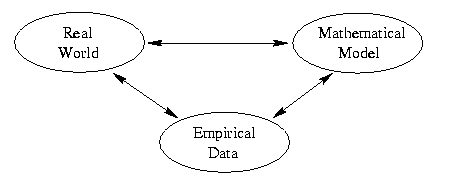|
|
Math 336 - Mathematical Modeling |
|
|---|---|---|
|
|
San Diego State University -- This page last updated 1-Feb-00 |
|
Math 336 - Mathematical Modeling
Instructor: Dr. Joseph M. Mahaffy
Office: Physics 243
Office Hours: To be determined
Text: Nonlinear Dynamics and Chaos by Steven Strogatz, Addison Wesley, 1994
- Introduction
- Static Models
- Modeling with Dynamical Systems
- Bifurcations
This course will examine mathematical modeling primarily from a dynamical systems point of view using the text listed above. However, since this course is on mathematical modeling, I will be emphasizing the modeling part of the dynamical systems, while the text uses applications to emphasize the study of dynamical systems. At times, I may venture away from the text to provide additional material on mathematical models or introduce a new area of application such as parameter identification or probabilistic modeling. Every attempt will be made to provide you with this additional material on the Web through this website.
The grading of this course will be based on your performance on the homework assignments, exams (both in-class and take-home), and a project. I have yet to determine the weighting of each of these, but your homework will be a major portion of these, so it is important to keep current on assignments. There will be a penalty for homework that is late. (Homework will be due on Friday (usually), and late homework will be assessed a 20% penalty for unexcused late work up until the homeworks are returned to class, after which homework will not be accepted.) At present, I am planning take-home and in-class exams in the middle and at the end of the class (though the in-class final may be replaced by oral presentations of the final project). You will choose a project based on your interests that will be presented both orally and in written form near the end of the semester.

A mathematical model is a representation of a real system. The essence of a good mathematical model is that it is simple in design and exhibits the basic properties of the real system that we are attempting to understand. The model should be testable against empirical data. The comparisons of the model to the real system should ideally lead to improved mathematical models. The model may suggest improved experiments to highlight a particular aspect of the problem, which in turn may improve the collection of data. Thus, modeling itself is an evolutionary process, which continues toward learning more about certain processes rather than finding an absolute reality. This use of mathematics is quite different from K-12 training in mathematics, where mathematics is treated as an absolute with exact answers.
Dynamical systems began with the advent of Calculus, which was formulated by Liebnitz and Newton in the mid-1600s. Until recently, the emphasis has been on finding exact solutions to the differential equations, which govern the dynamics of some modeling problem. However, early on scientists discovered that analytical methods failed with problems as simple as the three body problem of gravitational attraction from astronomy. Before computers, scientists worked on clever methods to simplify the modeling problem to make it more tractable, usually using some approximations.
In the late 1800s, Poincaré developed geometric methods to analyze mathematical problems. His perspective introduced the concept of qualitative analysis rather than quantitative analysis. Qualitative analysis looks into the behavior of dynamical systems and uses geometric techniques to predict what are the possible outcomes for certain nonlinear problems. Bifurcation theory developed to shown how behavior changed as certain parameters in the system changed. One of the outcomes of this analysis was the theory of chaos, which has been discussed widely in recent years since the popular book by James Gleick in 1987. The explosive growth in studying dynamical systems has been the high speed computer, which allows easy simulation of complex nonlinear problems.
This modeling course will begin with the study of ordinary differential equations, using the qualitative analysis techniques of our text. I will use specific examples to show the ideas of mathematical modeling, then the qualitative behavior of the dynamical systems will provide information on interpreting the mathematical models.
Read Chapter 1: Overview in the text.
You can now download Excel spreadsheets, complete with descriptions of what is going on how to create them for a Graphing Template, for a Trendline Template, for Discrete Models, for Newton's method, and Numerical Solutions to Differential Equations.
